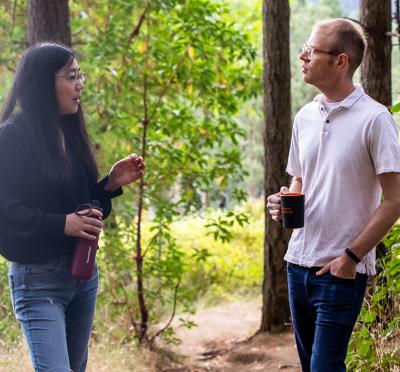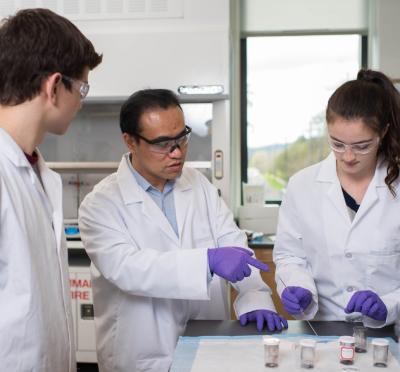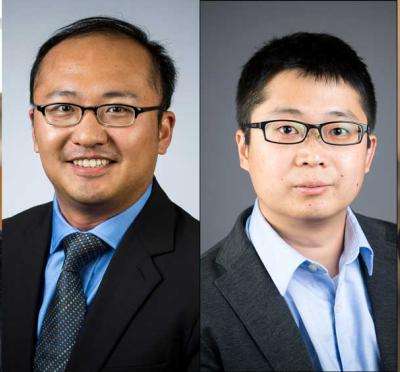
Since it was launched in 1998, the Peter and Rosalie Johnson Internship Program has provided paid research opportunities for hundreds of students in the School of Chemical, Biological, and Environmental Engineering.
Created at the initiative of Peter Johnson (’55 B.S., Chemical Engineering) and his wife, Rosalie, the program was endowed with a $2.4 million gift in 2008. Each spring, about 25 qualified first-year students are matched with research labs on campus, or with one of Oregon State’s academic partners.
In addition to a good, paid summer job and valuable training on laboratory equipment, Johnson Interns gain confidence and new perspectives from their research experience.
The Johnson program is special, says Professor Skip Rochefort, who administers the program, because there are very few comparable, intensive research opportunities available for students with only one year of schooling under their belts. The experience that Johnson Interns acquire in their first summer can be instrumental in assuring their future success.
“Our students compete nationally for internships and undergraduate research experience programs,” said Rochefort. “To be competitive for these positions, they need to have demonstrated mastery of skills not widely taught or practiced at other schools. This is what the Johnson Internship provides them in the summer following their first year.”

WHAT’S LURKING IN WASTEWATER
Jacquelynn Nguyen spent the summer of 2019 studying wastewater. While not where she expected to be, her work in the lab of Assistant Professor Tala Navab showed her there’s more to wastewater treatment than she initially thought. To collect wastewater samples, the environmental engineering major travelled to multiple wastewater treatment plants across Oregon.
“Every wastewater treatment plant had a different process that I could learn about,” she said. “It’s the same concept, but the structure or the chemicals they use might be different, which was really interesting. It gave me a lot of exposure to the process itself and why I'm studying it.”
After initially working with Navab on a greenhouse project, Nguyen continued working in her lab through the Johnson Internship Program. She worked with a team to collect wastewater samples to determine the presence of antibiotic-resistant bacteria.
“We looked at the concentrations that are being released from treatment plants,” Nguyen said. “We did physical and chemical tests on the wastewater and looked at its pH and its conductivity. Then we would look at what we incubated and check for the presence of E. coli. and store that for further testing in another season.”
Nguyen benefitted from the hands-on experience of working in a lab. In addition to collecting, incubating, and filtering bacteria samples, she enjoyed the team environment, managing tasks with her lab mates, and socializing together outside of work.
Nguyen’s interests are piqued now, thanks to her work with Navab. She plans to continue research in this area.
“Wastewater treatment plants don’t regulate how much antibiotic-resistant bacteria they release,” she said. “I want to understand how this happens and how we can more effectively filter out these bacteria.”

WRANGLING BACTERIA
In Associate Professor Kate Schilke’s lab, adhesion is the name of the game. Cormack Pegau spent his summer of 2019 considering this phenomenon at the microscopic level. As an intern in Schilke’s lab, the bioengineering major worked on a research project studying the use of an immobilized protein as a treatment for sepsis, a potentially life-threatening condition caused by the body's response to an infection.
For many people, sepsis treatments are not readily available because they are either too expensive or ineffective against a late-stage diagnosis. Instead of treating the symptoms, Schilke’s research focuses on stopping the problem.
The immobilized proteins, modified by genetic code expansion, bind to and remove dead bacteria and fragments of their cell membranes in the blood that could cause a severe immune response.
“Most of my job was bacteria wrangling,” Pegau said.
As part of the Johnson program, Pegau wrote reflections about his internship experience. It made him think about the importance of translating his work in the lab for people without engineering backgrounds.
“It helped me see why my work is important,” Pegau said. “Suddenly people are interested in your work because it's not just something a big, scary scientist is doing out in the distance.”
Pegau is glad he got the chance to take the summer to focus on research.
“It was a test run for actually going into industry or academia,” he said. “It helped me understand what I enjoy doing.”

FROM SEAWATER TO CLEAN ENERGY
Working in the lab of Assistant Professor Kelsey Stoerzinger, Cindy Wong spent her summer of 2019 researching seawater electrolysis.
While Wong had prior research experience in materials science, the chemical engineering major was looking for a way to combine this with her interest in clean energy.
“There's a modern challenge right now–finding efficient methods to store renewable energy,” she said.
Stoerzinger’s lab investigates electrolysis of seawater because it’s naturally abundant and cheaper than freshwater. In electrolysis, water is split into its component parts, hydrogen and oxygen. Energy is stored in the bonds of hydrogen and oxygen and released when the two are combined to make water. Working with seawater comes with challenges though, as the chlorides it contains make it much harder to perform electrolysis.
“Our main goal was to see how electrodes behaved depending on which catalysts they were coated with,” Wong said. “Which ones were the best at reducing chlorine evolution and maximizing oxygen evolution?”
Wong learned to run experiments, collected data on the performance of different metal catalysts, and eventually took the lead for several mini projects within the lab. She also had the chance to serve as a mentor for three high school students during the Summer Experience in Science and Engineering for Youth program.
Wong found her Johnson internship immensely valuable and she’s already noticed a positive response from prospective employers as she interviews for future internships. She encourages other students to give research a try, regardless of their background.
“I gained a lot of hands-on, technical skills,” Wong said. “I had never used electrochemical instruments before. This experience influenced me to pursue research in the future and consider applying to graduate school.”



